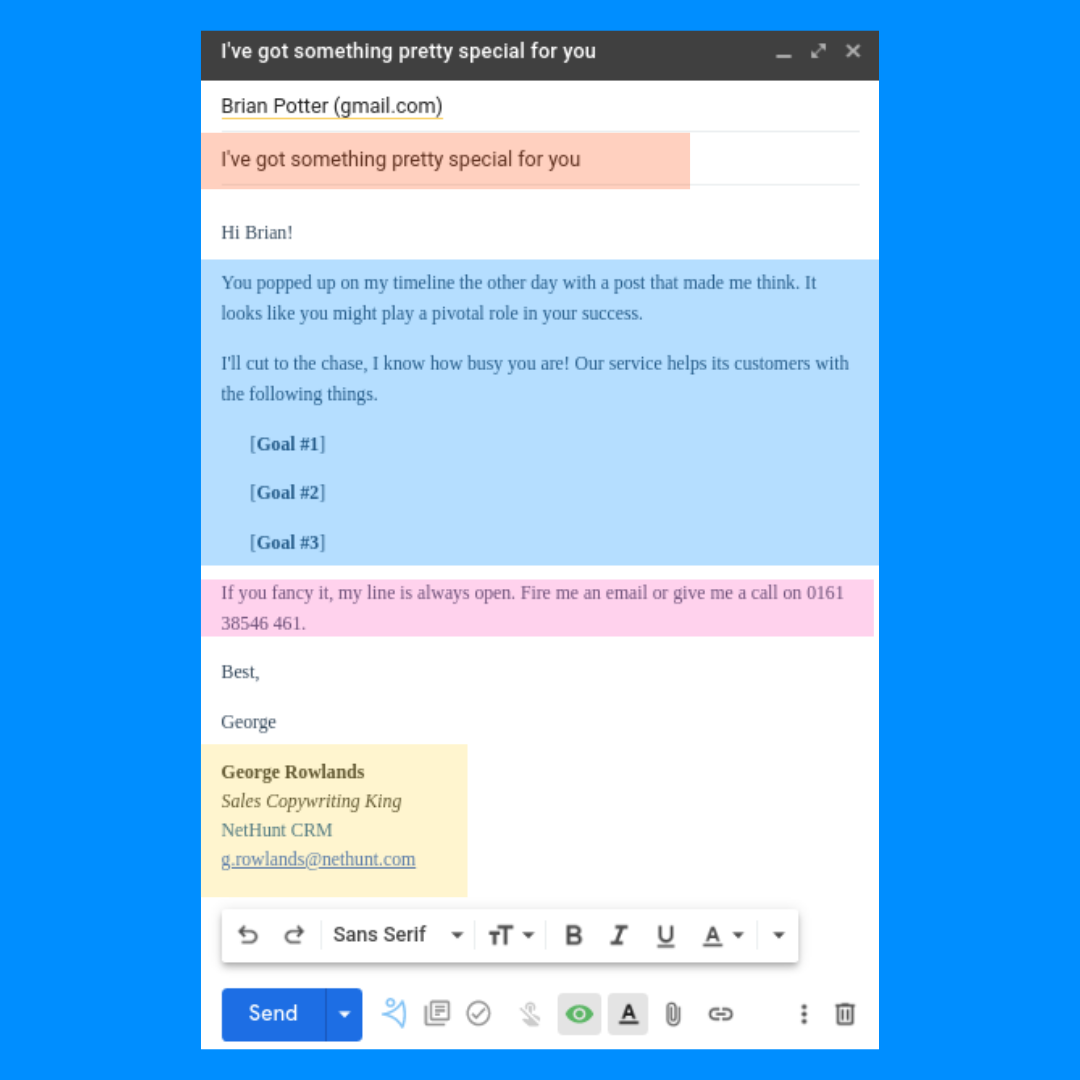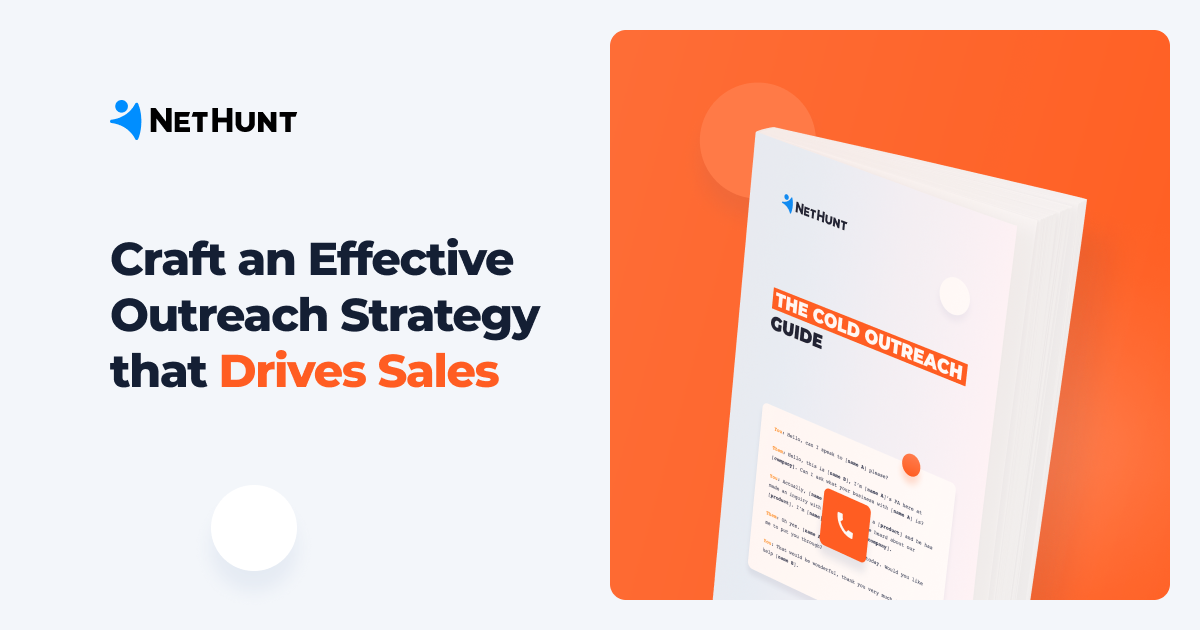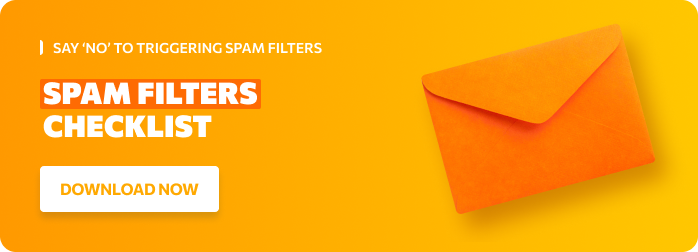Have you ever had writer’s block all day?
Have you ever sweated over a sales email to the perfect prospective client, written it out, deleted it, and then written it out again? Saved it to drafts because you’re too scared to send it?
Ever found the courage to finally send it… and then not receive a reply?
We know we have. We know everybody has.
Sales email copywriting is a tough nut to crack. Finding the right words for your sales email is never easy. After all, you only really get one shot at it.
So, let’s find the words together. Welcome to The Guide to Sales Email Copywriting, where we’ll talk you through every step of the sales email copywriting process… with templates, of course.
What is sales email copywriting?
Email copy is the words you include in your email subject lines and body. In sales, it's your chance to communicate the value and relevance of a product or service to customers. In the modern business world, getting the copy of your emails spot on is essential.
Sales email copywriting should be no different from any other form of copywriting, but it sort of is. Sales emails tend to be cold and out of the blue; potentially unrequired and often unrequited. With this in mind, successful sales emails need to be three things at once - Brief. Persuasive. Actionable.
Outbound sales emails are all about numbers. We’re trying to get our product or service in front of as many eyes as possible. First of all, we want to catch attention. Secondly, we want to get as many replies to our emails as possible. It’s easier to think of it as a three step process, maximum.
- Get your email opened with your subject line.
- Maximise responses with persuasive copy.
- Follow up until you finally do get a response.
In a nutshell - you’re just trying to start a conversation.
How to structure a sales email.

- The subject line.
- The email body.
- The call-to-action (CTA).
- The signature.
The things to know before you write.
Be as brief as possible.
Brevity is key. Nobody wants to read your life story, especially if they didn’t even ask for an email in the first place. People are busy, and they haven’t got time for your wonderfully-written words.
The ideal length of any email is between 50 and 125 words; emails of this length offer the highest chance of receiving a reply. A similar study found emails with approximately 20 lines of text, or about 200 words, had the highest clickthrough rates. As a rule, let’s keep it under 200 words.
The whole email should be focussed on the same goal.
Imagine you’re telling a story and there’s one, big happy ending. The subject line and the preview should set the scene of your email, the opening line should ease us into the main event: the body. The CTA is our hero, saving the day and giving us that happy, happy ending - a follow through. The signature? Well that’s your bio as the author - a way of saying ‘if you like my stuff, get in touch’
Being personal means knowing who a recipient is.
Writing generic emails to undefined lists of people is a very quick way to a sales fail. Your business should have plenty of data behind its copywriting, whether it’s gleaned from the internet or brainstormed between the team. A buyer persona is essential - your emails should be sent to segmented lists of recipients for maximum input. Take a look at NetHunt CRM’s buyer persona.


So, Ali is money orientated… so I’ll talk about the price of my product. I get that they want to close more deals, so I’ll talk about how my product does that. I’ll provide a comforting word about their fears for CRM being difficult to set up and learn. It’s not.
Outreach should be based on a persona and your business should have drawn several personas, at that.

The subject line.
I’d like to propose a toast to the copywriters of this world, quietly churning out quality content; doing their bit to keep brands relevant and engaging. But, imagine our sad little faces when you don’t open that newsletter we spent days writing. Hang in there guys, we got this.
But the truth is, Shakespeare could have written a blog about the top 5 features of NetHunt’s Gmail integration, but if the subject line was left blank then nobody would read it. According to Invesp’s research, as many as 69% of recipients send a message to spam based on its subject line.
Bloody hell.
In 2021, a good sales email copywriter also needs to be a good sales email subject-line writer. To become one of those, you should be privy to the rules that dictate what makes a subject line good. Luckily for you, the nice guys at NetHunt (me) have put all those rules together for you.
- Keep it short and sweet. Your subject line is much more like to be opened if it only contains 6 to 10 words. If it contains 21 to 25 words, it's way too long. People won't even read it and it's only got a 9% chance of being opened.
- Add some urgency. Subject lines using urgent language at 22% more likely to be opened than those that aren't. Urgent language implies there is limited time attached to whatever you've got to offer, so they should act fast.
- Say it with a smile. Emojis aren't tacky, they aren't childish, and they aren't inappropriate... even for a sales email. They're part of our language. Brands that use emojis in their subject lines can see a 56% open rate. Here's an emoji guide.
- Personalise it. At the very least, you should know your recipient's name. If you do and if it fits, you can include that name in your subject line. We'll talk more about personalisation later - but a name is a nice touch, if nothing more.
Sales email subject line examples.
- Idea for achieving [goal]
- [referee] told me about you...
- Loved yor recent post!
- It’s great to meet you [name]!
- I can make your life easier.
- Can you help me?
- This is a sales email - sorry.
- Question about [goal]
- [name] I’ve seen you about.
- Hi [name], I am the demo master.
- Hoping to help.
- A [benefit] for [prospect's company]
- I’ve had an idea for [company name]
- I figured it out.
Don’t forget about the preview text. Once you jump over the subject line hurdle, a recipient’s attention is likely to wander to the preview text of your email. Email preview text is between 35-90 characters. There are also email clients that don't display any preview text. Make sure the first sentence of your email is friendly, engaging, and emphasises exactly what your email says.
The body.
Slip through the Spam filters.
Your job is to engage, persuade, and encourage your interlocuteur - but you’ve got to get in their inbox. No matter how perfect your product fit is, how easy it would make your recipient’s life, or how determined you are to sell it… you’ve got to land in the inbox first.
Spam filters detect unwanted, often virus-infected emails, and prevent them from ever reaching a recipient’s inbox. They’re automatic; put in place by internet service providers, email clients, and businesses themselves to stop any nasty infections getting into the network.
You might think yeah, but I’m not spam - it’ll be fine. Trust me pal, many have said that before and been wrong. Your email is probably unsolicited, so it looks more like spam than you think.
Avoid the spam filter at all costs. Avoid including spam trigger words in your emails.
- Click here
- Full refund
- Affordable
- Bargain
- Best price
- Cash
- Cash bonus
- Cheap
- Credit
- Discount
There are a bunch of trigger words that’ll get you sent to spam - check out this definitive list of them.
Include persuasive triggers.
Similarly, but oppositely, there are a bunch of words that you can include in your email that’re going to enhance your chances of engaging a recipient and getting that response that you need. Persuasive trigger words are all about putting out positive vibes. There’s no specific words that’ll seal the deal for you, but a group of words that are likely to give you a better chance of securing the deal.
- Gorgeous
- Pristine
- Imagine
- Luxurious
- Rare
- Few
- Scarce
- Hurry
- Tempting
- Illusive
Forward, the most persuasive technique you can use in copywriting is social proof. Humans are social creatures with a herd mentality. Attitudes, beliefs, and behavior are influenced by the presence or action of others.
84% of millennials say that user-generated content from other buyers influenced a decision.
Source: Lexy Wright
Social proof comes in different forms. Still, based on the essential principle of brevity in a sales email - you’re not going to be able to use them all. Pick and test your preferred medium of social proof and add a light dash of it to your writing. Earned authority is using the voice of somebody well-known to better the image of your product. Proven authority is using numbers to prove that people like your stuff. Borrowed authority is a chance to show how your product has been featured in any media.
Be as personal as appropriate.
Remember mail merge? Brands are quite rightly using it still, but it used to be the cutting edge of personalisation technology. I still come across blogs telling me that ‘yah, your name is the most powerful word in linguistics - mail merge will change your life’. Give me a break.
It’s the 21st century and personalisation refers to behaviours, preferences, and individual attributes of our recipients. There are a bunch of different personalisation strategies to use. Use them.
- Mail merge. NetHunt CRM’s got a mail merge and that’s the last thing I’ll say about it.
- Buyer personas. Your recipients should be categorised and segmented based on t any number of variables, such as demographics, behaviour patterns, motivations, and goals. The more detailed a buyer persona is, the more precise a brand can be in its targeted messaging.
- Trigger events. A sales email is most effective when a recipient has shown some kind of interest in your product. With the right tools in place, your business can identify those trigger events, be notified when they occur, and automatically send a sales email.
- A compliment. Did anybody ever tell you you’ve got an amazing smile? That felt good, didn’t it. It’s best to keep your compliment professional in a sales email. ‘Hey, I really liked your LinkedIn post the other day’ or ‘great job on that webinar the other day!’.
- A/B Testing. Create multiple versions of the copy and test which copy gets more conversions. Consider using HubSpot’s sales email templates to get a head start. Because, hey! Why start from scratch?
Apart from that, being personal in a sales email means including some personality in your email. When sending an email to an individual client, it’s okay to include a joke, a reference to the weather, or some other information that identifies you as being a human. Be honest. Be humble. Speak your recipient’s language. Say something relevant to current events at the time.
NetHunt’s Hot Tip
One great way of humanising your outreach is to talk about what’s going on behind-the-scenes of your business. Let your guard down for a minute and talk about something that’s going on in the office today - the air conditioning in marketing is broken or you’re buzzing that a bunch of biscuits have been left out in the kitchen. Forget you’re selling for a second - talk about life.
Remember: You’re trying to start a conversation - only humans can have a conversation.
We also prepared the article with multiple tips on email personalisation to get the prospect's attention.
The CTA.
Start your CTA with an action word.
A CTA is literally a call to action. You’re asking somebody to do something for you, and the only way to be clear about this is to start your CTA with an action verb. You’re not emailing them to ask about the weather, you’re emailing to get an email back or to make them visit a website… so tell them exactly what you want them to do. Don’t dilly-dally, just do it. Oh look, that was a CTA!
Don’t be basic; be rambunctious.
Let’s explore the boundaries here a little bit. You’re a professional copywriter, afterall; you’re also trying to grab your recipient’s attention. Words have different impacts depending on the frequency we hear them. Take 'the' for example - what a boring word. We hear the so often, that we don’t even realise it anymore. Now take the word 'rambunctious', which means noisy and lacking restraint. Now that’s an interesting word. I'd be impressed if I saw that in an email.
But you probably won’t use that word, it’s irrelevant. Here are some low-frequency action verbs that could very well grab reader attention, and tip them over the edge of action. This is by no means a definitive list of low-frequency words, there are plenty more out there.
- Smash
- Wallop
- Busy
- Consider
- Crash
- Contemplate
- Request
- Command
- Call the shots
- Secure
- Triumph
- Prevail
- Conquer
- Accomplish
Be realistically actionable.
Your CTA should always be a hyperlink, otherwise what’s the point? If it’s not, it should simply be asking your recipient to reply to you. The path after your CTA should be clear.
The signature.
An email signature is the business card of the 21st-century. Before anything else, it should include your name, company, job title, and phone number. There’s no super-duper copywriting trick to creating a nice email signature. In fact it should involve as little copywriting as possible.
Just keep it simple.
Learn how to make a professional email signature!
Sales email templates.
Templates are good, but they should only ever be used as inspiration. Your sales email should be personal, engaging, and tailored to each individual client you reach out to. It should employ all of the strategies above in order to achieve the CTA you set.
Still, a bit of inspiration helps. A sales email looks like this.
#1 Keep it personal
Hi [name],
I just wanted to introduce myself. I’m [name] and I work with small businesses in your industry space. I noticed that one of your colleagues filled out a web form on our website very recently. We loved that in the office!
I decided to do a little bit of research on your business to see what we can do for you.
It turns out that we’re working with one of your soft competitors, [competitor]. We provide them with the tools to manage [something]. They’ve seen results of [statistics], which were beyond what even we expected!
If you’re interested, I’d love to show you what we could do for you.
Grasp this opportunity - book in a demo today!
Thanks,
[signature]
#2 Short and sweet
Hi [name],
I'll keep this short and sweet. In fact, it’ll only take 19 seconds to read this email… quickly.
I timed it.
I work for [company]. My job is to find people like you who want to achieve [goal]. You came onto my radar because you recently signed up for our newsletter, so I did a bit of research on your company.
I’d love to show you what our product can do towards helping you achieve that [goal].
Attack the goal - just reply to this email and we’ll get something booked in.
Best,
[signature]
#3 Follow up
Hi again!
I didn’t hear back from you, so I just want to make sure you didn’t miss my last email. Is [achieving goal] something you'd still be interested in discussing?
We’ve got features coming out of our ears that are going to help you do it.
[feature #1] is helpful because...
[feature #2] is helpful because...
[feature #3] is helpful because...
Wallop the competition out of the park - a demo is only going to take 20 minutes or so.
What do you think?
[name]
We've done the analysis of the sales email templates generated by ChatGPT, it's worth checking.
The rest is up to you. I'll see you in my inbox!
Table of Contents
Crack the sales formula with CRM Lab
Twice a month, receive actionable CRM content to your inbox.
![A guide to sales email copywriting [+templates]](https://images.unsplash.com/photo-1556505619-58f906d76346?crop=entropy&cs=tinysrgb&fit=max&fm=jpg&ixid=MnwxMTc3M3wwfDF8c2VhcmNofDI3fHxrZXlib2FyZHxlbnwwfHx8fDE2MjQ2MjM3Njg&ixlib=rb-1.2.1&q=80&w=2000)




